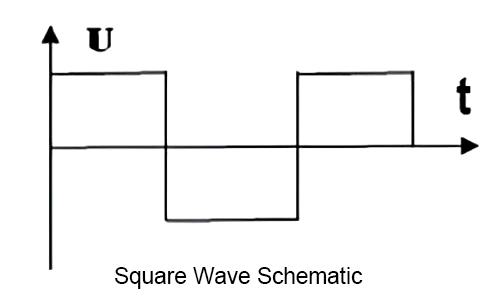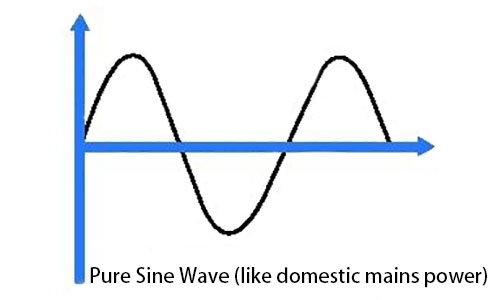In modern life, electricity is one of the infrastructures that we cannot live without. However, there are times when we find ourselves in a situation where we need to work or live without a conventional power supply. This is where a power inverter becomes our right-hand man. A power inverter is a device that converts direct current (DC) to alternating current (AC) and can be used in a wide range of scenarios, from home emergency backup to outdoor camping, vehicle power, etc. Power Home will introduce you to the several types of power inverters that can be categorized.
Designed to facilitate residential and off-grid living, power inverters are sufficient for most household appliances. Featuring a selectable range of input DC voltage, a selectable range of output voltage, and a selectable range of output frequency makes them more widely applicable. Different types of power inverters play important roles in different application scenarios, and their continuous development and innovation will further promote the development of power electronics technology and provide more reliable and efficient solutions for energy conversion and utilization in modern society.

According to the inverter output AC power frequency, can be divided into the inverter, medium frequency, and high-frequency inverter.
Inverter: The frequency of the industrial frequency inverter is 50/60Hz, which converts DC reverse to frequency low-voltage alternating current. Then it converts the industrial frequency transformer step-up to AC 220V, 50Hz power supply load. It has the advantage of a simple structure and can realize various protection functions at lower voltage. There is an inverter between the inverter and the load, so the inverter is stable and reliable in operation, has a high load capacity, high shock resistance, and can also suppress high harmonic components. However, inverters have the problem of being bulky and expensive and their efficiency is relatively low. The rated load efficiency of low-power inverters does not exceed 90% at current levels.
Medium Frequency Inverters: Inverter efficiency at low power output is more important than peak efficiency. Inverter systems are better suited for isolated systems (where the user is usually loaded below peak power). Inverters can withstand higher load power impacts. (Medium Frequency) Inverters Medium frequency inverters are available from 400Hz to 10,000Hz.
High-Frequency Inverters: High-frequency inverters typically have frequencies over a dozen kHz to MHZ. figure 2 shows a power inverter circuit for a high-frequency transformer. Low-voltage DC inverters for high-frequency low-voltage AC utilize high-frequency DC/DC converter technology. After the high-frequency step-up transformer, a high-frequency rectifier circuit rectifies the high-voltage DC which is usually 300V or more. Finally, a 220V 50Hz frequency inverter circuit is obtained to provide AC power to the load. Since high-frequency inverters are used in small, lightweight high-frequency cores, the power density of the circuit is greatly increased, resulting in low no-load losses and improved efficiency of the inverter. Small to medium-sized PVS HF inverters typically have peak energy conversion efficiencies of over 90%.
Other Basis of Classification:
- According to the form of the inverter main circuit, it can be categorized into single-ended inverter, push-pull inverter, half-bridge inverter, and full-bridge inverter.
- According to the type of main switching device of power inverters, they can be categorized into thyristor inverters, transistor inverters, field effect inverters, and insulated gate bipolar transistor (IGBT) inverters. It can also be classified into two main types: "semi-controlled" inverters and "fully controlled" inverters. The former has no self-shutdown capability, and the element is out of control after conduction, called a "half-control" general-purpose thyristor. The latter has an automatic shutdown function, without needing equipment on and off, which can be controlled by the control electrode, known as "full control". Power field effect transistors and insulated gate bipolar transistors (IGBT) belong to this category.
- Depending on the DC power source, they can be categorized into voltage source inverters (VSI) and current source inverters (CSI). The former has an almost constant DC voltage and the output voltage is an alternating square wave. The latter has an almost constant DC and the output current is also an alternating square wave.
Output Waveforms
Depending on the circuit design, the power inverter for home may produce square, sine, modified sine, pulsed sine, or near-sinusoidal pulse-width modulated (PWM) waves. Common types of inverters produce square or quasi-square waves. One measure of sine wave purity is total harmonic distortion (THD). Technical standards for commercial distribution grids require that the THD of the waveform at the customer's point of connection be less than 3%.IEEE Standard 519 recommends that systems connected to the grid reduce THD to 5%.
There are two basic designs for generating household plug-in voltage from a low-voltage DC source. the first uses a switching boost converter to generate higher voltage DC power, which is then converted to AC power. The second method converts DC to AC at the battery level and uses a line frequency transformer to generate the output voltage.
Square Wave
This is one of the simplest waveforms an inverter design can produce and is best suited to low-sensitivity applications such as lighting and heating. The square wave output produces a "hum" when connected to audio equipment and is generally unsuitable for sensitive electronic devices. A 50% duty cycle square wave is equivalent to a sine wave with 48% THD.

Pure Sine Wave Inverter
- A power inverter device that produces a multi-step sinusoidal AC waveform is called a sine wave inverter. Manufacturers often use the phrase pure sine wave inverter to distinguish inverters with much less output distortion than the improved sine wave (three-step) inverter design. Almost all consumer-grade inverters sold as "pure sine wave inverters" do not produce a smooth sine wave output at all, just choppy outputs compared to a square wave (two-step) and modified sine wave (three-step) inverters. However, this doesn't matter for most electronic devices because they can handle the output just fine.
- Sine wave output is desirable when power inverter equipment replaces standard line power because many electrical products are carefully designed to work best with sine wave AC power. Standard power companies provide sine waves, usually with minor imperfections, but sometimes with significant distortion.
- Sine wave inverters with more than three levels of wave output are more complex and significantly more costly than square wave (one-step) type sine wave inverters with only three levels or the same power handling. Switching-mode power supply (SMPS) devices (such as personal computers or DVD players) run on modified sine wave power. AC motors that run directly on non-sinusoidal power may generate additional heat, may have different speed-torque characteristics, or may produce more audible noise than when running on sinusoidal power.

For More Information on Realizing Sine Waves
- A resonant inverter generates a sine wave through an LC circuit to remove harmonics from a simple square wave. There are usually multiple series resonant and parallel resonant LC circuits, each tuned to a different harmonic of the power line frequency. This simplifies the electronics, but the inductors and capacitors tend to be large and heavy. Its high efficiency makes this method popular for large uninterruptible power supplies in data centers, which run the inverter continuously in an "online" mode to avoid any switching transients during power outages. (See related article: Resonant Inverters)
- A closely related approach uses iron resonant transformers (also known as constant voltage transformers) to eliminate harmonics and store enough energy to sustain a load for several AC cycles. This characteristic makes them useful in backup power supplies to eliminate switching transients that occur during power failures while the normally idle inverter starts up and mechanical relays switch to its output.
Modified Sine Wave Inverters
- The cigarette lighter produces a waveform 12 V DC to 120 V AC 60 Hz inverter. The corrected sine wave is the sum of two square waves, one of which is delayed by one-quarter of a period relative to the other. The result is a repeating sequence of voltage steps of zero, peak positive, zero, peak negative, and zero again. The resulting voltage waveform more closely resembles the shape of a sinusoidal voltage waveform than a single square wave. Most inexpensive consumer power inverters produce a modified sine wave rather than a pure sine wave.
- If the peak voltage value of the waveform is chosen to be half the cycle time, the ratio of the peak voltage to the RMS voltage is the same as for a sine wave. The DC bus voltage can be actively adjusted, and the "on" and "off" times can be modified to maintain the same RMS value output up to the DC bus voltage to compensate for changes in the DC bus voltage. The harmonic spectrum can be changed by varying the pulse width. A three-step corrected sine wave has a minimum THD of 30% when the pulse is 130 degrees wide at each electrical cycle. This is slightly lower than a square wave.
- With pulse width modulation (PWM) techniques, the ratio of on-time to off-time can be adjusted to vary the RMS voltage while maintaining a constant frequency. The generated gate pulses are supplied to each switch according to the developed pattern to obtain the desired output. The harmonic spectrum in the output depends on the width of the pulse and the modulation frequency. It can be seen that the minimum distortion of the three energy level waveform is achieved when the pulse extends above 130 degrees of the waveform, but the generated voltage will still have a THD of about 30%, which is higher than the commercial standard for grid-connected power supplies. Voltage harmonics are usually not considered when operating induction motors. However, harmonic distortion in the current waveform introduces additional heat and can produce pulsating torque.
- Many electrical devices operate well on improved sinusoidal power inverter devices, especially resistive loads, such as conventional incandescent light bulbs. Items with switching power supplies will run almost completely without problems, but if the item has a power transformer, this may overheat, depending on its rating.
- However, the load may run less efficiently due to the harmonics associated with the corrected sine wave and produce a humming sound during operation. This can also affect the efficiency of the overall system, as the manufacturer's nominal conversion efficiency does not take harmonics into account. Therefore, a pure sine wave inverter may provide significantly higher efficiency than a modified sine wave inverter.
- Due to harmonic content, most AC motors will run on MSW inverters with about 20% lower efficiency. However, they can be quite noisy. A series LC filter tuned to the fundamental frequency may help.

Near-sinusoidal
An example of PWM voltage modulation is a series of pulses. Low-pass filtering using series inductors and shunt capacitors is required to suppress the switching frequency. After filtering, a near-sinusoidal waveform is produced. The filtering components are smaller and more convenient than those needed to smooth the corrected sinusoidal waveform to an equivalent harmonic purity.
Some inverters use PWM to create waveforms that can be low-pass filtered to recreate a sine wave. The way MSN designs them, these require only a DC power supply, but the switching takes place at a much faster rate, typically many kHz so that changes in pulse width can be smoothed to produce a sine wave. If a microprocessor is used to generate the switching timing, the harmonic content and efficiency can be tightly controlled.
Typical Applications for Power Inverters Include:
- Portable consumer devices allow the user to connect a battery or group of batteries to the device to generate AC power to run a variety of electrical devices such as lights, televisions, kitchen appliances, and power tools.
- Used in power generation systems, such as electric utilities or solar power systems, to convert DC power to AC power.
- Used in any large electronic system where there is an engineering need to derive AC power from a DC power source. For example, DC-powered electronic equipment may contain a small inverter for powering electroluminescent or fluorescent backlighting, which requires high-frequency AC power, the
- Utility Frequency Conversion - If (for example) a customer in a 50 Hz country needs a 60 Hz power supply for a specific frequency device (such as a small motor or some electronic equipment), the frequency can be converted by running an inverter with a 60 Hz output from a DC power supply, such as a 12V power supply running from a 50 Hz power supply.

With the Powerhome Online Shop, you can easily find a wide range of models and sizes of multi-power power inverters to meet the needs of different power usage and applications. This online store offers high-quality products that guarantee a stable and reliable power supply for your home or workplace. Whether you need emergency backup power for your home or power support for your industrial equipment, Multi-Power Power Inverters are up to the task.
Purchasing a multi-power inverter is not just about solving the problem of sudden power outages, but also about ensuring that our lives and work are not affected by interruptions in off-grid-living power supply. Therefore, it is very important to choose a reliable and efficient multi-power inverter, Powerhome.com provides a convenient and fast shopping experience, so you can easily shop for the power inverter that meets your needs. Whether you're buying a power inverter for your home or workplace, you can count on us to deliver the products and services you need. Let's work hand in hand with a multi-power power inverter to bring more convenience and safety to our lives and work.
(1).png)
(1).png)